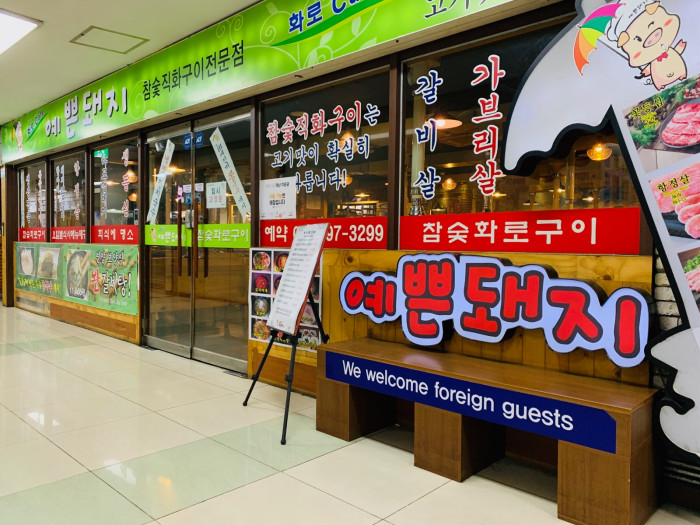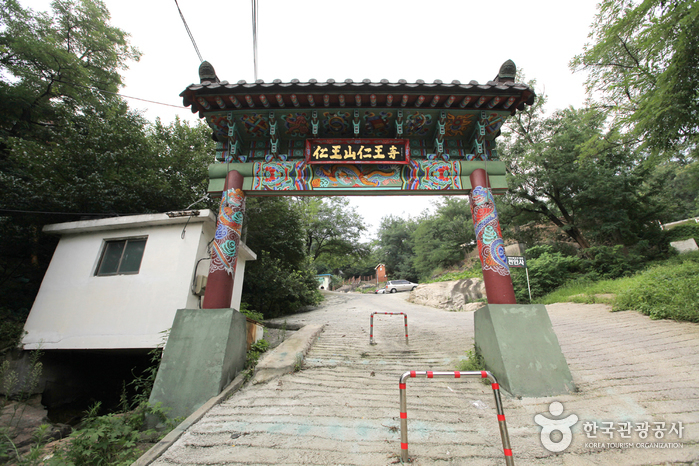Mook - Lotte Factory Gasan Branch [Tax Refund Shop] (무크 롯데팩토리 가산)
13.6Km 2024-06-27
278, Beotkkot-ro, Geumcheon-gu, Seoul
-
Pakumori - Hongdae Branch (파쿠모리 홍대)
13.6Km 2021-03-19
132-1, Eoulmadang-ro, Mapo-gu, Seoul
+82-2-3142-5553
This Japanese cuisine is located near Hongik Univ. Station, Seoul. The representative menu is house-made pork cutlet. A Japanese curry specialty store.
Yeppeun Dwaeji(예쁜돼지)
13.6Km 2021-03-19
278, Beotkkot-ro, Geumcheon-gu, Seoul
+82-2-3397-3299
A BBQ specialty store using charcoal. The most famous menu is grilled salted pork shoulder. A barbecue specialty restaurant located in Guro-gu, Seoul.
The Saem - Hongdae Branch* [Tax Refund Shop] (더샘 홍대점*)
13.6Km 2024-04-22
98-1, Eoulmadang-ro, Mapo-gu, Seoul
-
Artbox - Seogyo Branch [Tax Refund Shop] (아트박스 서교)
13.6Km 2024-04-18
#101, and #103, 19, Hongik-ro, Mapo-gu, Seoul
-
Too Cool For School - Hongdae Branch (No. 2) [Tax Refund Shop] (투쿨포스쿨 홍대2호)
13.6Km 2024-04-18
102, Eoulmadang-ro, Mapo-gu, Seoul
-
Olive Young - Techno Mart Sindorim Branch [Tax Refund Shop] (올리브영 신도림테크노마트 [사후면세점])
13.6Km 2024-04-22
B1, a section of Store #45, #46, 97, Saemal-ro, Guro-gu, Seoul
-
E-Mart - Sindorim Branch [Tax Refund Shop] (이마트 신도림 [사후면세점])
13.6Km 2024-04-17
B2 Techno Mart, 97, Saemal-ro, Guro-gu, Seoul
-
Seodaemun Independence Park (서대문독립공원)
13.6Km 2022-12-15
251, Tongil-ro, Seodaemun-gu, Seoul
+82-2-3140-8305
Seodaemun Independence Park was built on the former Seoul Detention Camp. It was used to imprison thousands of Korean independence activists until the liberation from the Japanese occupation on August 15, 1945, as well as the political prisoners during the political turmoil in the 1960s. When the prison was moved to Uiwang-si, Gyeonggi-do in November 1987, the area was restored and turned into a memorial park in August 15, 1992 to honor the sacrifices of the martyrs. The park preserves seven prison buildings, an execution ground, underground women’s prison, and the March 1st Movement Monument that has been moved from Tapgol Park in Jongno.
One of the most significant monuments of the Seodaemun Independence Park is Dongnimmun Gate (Independence Gate), which has been designated a Historic Site. Nearby is Dongnipgwan (Independence Hall), originally called Mohwagwan, which was used to greet Chinese envoys during the Joseon dynasty. Today, the hall enshrines 2,327 tablets inscribed with the names of Koreans who died for the cause of national independence. Standing right next to Dongnimmun Gate are the remnants of Yeongeunmun Gate, another Historic Site. Other sights inside the park include the Patriotic Martyr Monument, Declaration of Independence Monument, and Statue of Dr. Seo Jae-pil, who was an independence activist and publisher of Korea’s first independent newspaper. The main highlight of the park is the Seodaemun Prison History Hall, a former prison building that was renovated into a history museum.
Inwangsa Temple (인왕사 (서울))
13.6Km 2020-04-02
16-1, Tongil-ro 18ga-gil, Jongno-gu, Seoul
+82-2-737-4434
Inwangsa Temple refers to the entire cluster of small Buddhist temples located on Inwangsan Mountain (alt. 338m) in the heart of Seoul. The eastern foot of the mountain has many scenic spots with its distinctively cozy and tasteful atmosphere, and the northern area called Mugye-dong also offers beautiful scenery. Inwangsa Temple was established in the early Joseon period (1392-1910) to guard the national palace Gyeongbokbung. The temple is comprised of 11 shrines from five different Buddhist orders. The unique design of each shrine adds pleasure to hikers on their way up to Seonbawi, an unusual rock formation that is a site of many folk beliefs and shamanist rites.
![Mook - Lotte Factory Gasan Branch [Tax Refund Shop] (무크 롯데팩토리 가산)](http://tong.visitkorea.or.kr/cms/resource/87/3314387_image2_1.jpg)


![The Saem - Hongdae Branch* [Tax Refund Shop] (더샘 홍대점*)](http://tong.visitkorea.or.kr/cms/resource/63/2887863_image2_1.jpg)
![Artbox - Seogyo Branch [Tax Refund Shop] (아트박스 서교)](http://tong.visitkorea.or.kr/cms/resource/62/2889062_image2_1.jpg)
![Too Cool For School - Hongdae Branch (No. 2) [Tax Refund Shop] (투쿨포스쿨 홍대2호)](http://tong.visitkorea.or.kr/cms/resource/09/2888609_image2_1.jpg)
![Olive Young - Techno Mart Sindorim Branch [Tax Refund Shop] (올리브영 신도림테크노마트 [사후면세점])](http://tong.visitkorea.or.kr/cms/resource/02/2880202_image2_1.jpg)
![E-Mart - Sindorim Branch [Tax Refund Shop] (이마트 신도림 [사후면세점])](http://tong.visitkorea.or.kr/cms/resource/96/2880196_image2_1.jpg)


 English
English
 한국어
한국어 日本語
日本語 中文(简体)
中文(简体) Deutsch
Deutsch Français
Français Español
Español Русский
Русский